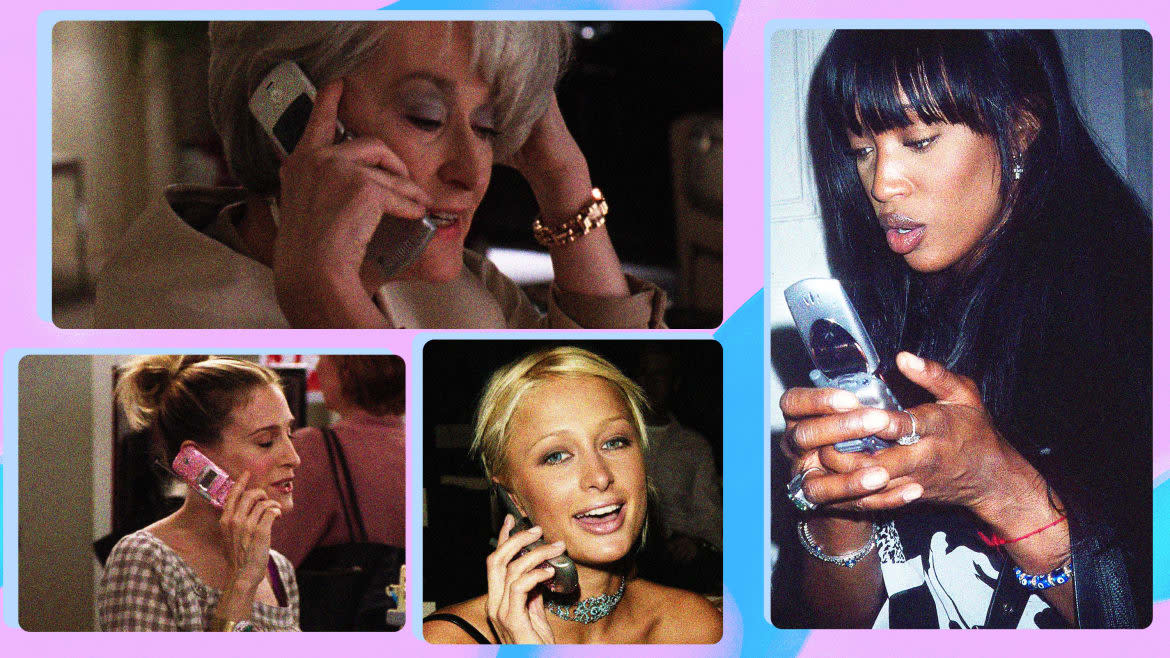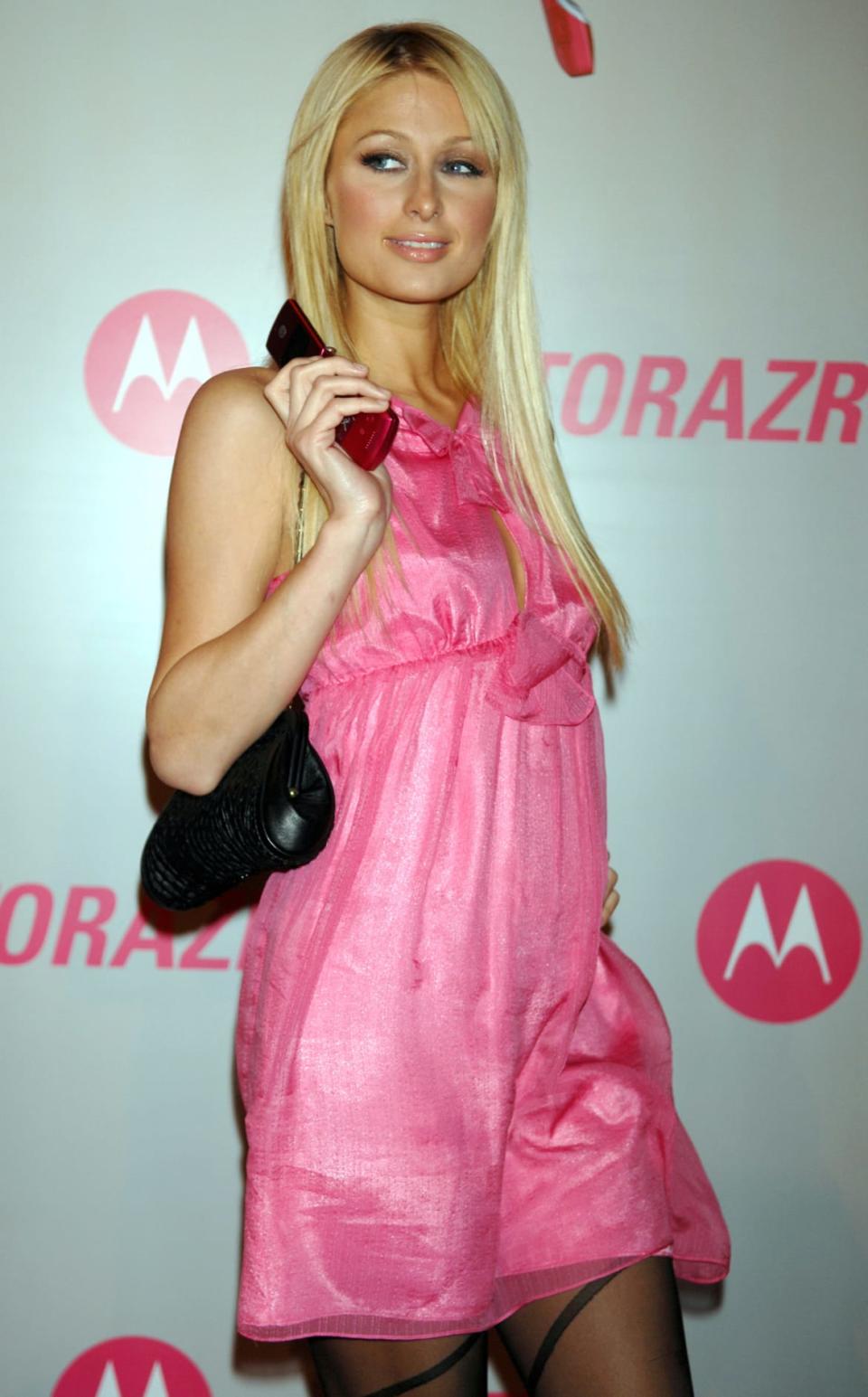Why Cellphones Should Return Girly and Glorious 2000s Designs

- Oops!Something went wrong.Please try again later.
The next time you’re at a bar, your friend’s house, or minding your business on the bus, glance around you, and count all the cellphones. You’ll tally more than you usually notice—all the tech guys at the bar will be data-scraping Hinge, or the toddlers on the bus will be appraising Bluey.
In the 16 years since the start of the (now-concluded) smartphone boom, phones have transformed from conspicuous, clicky calculators to totally ignorable shadows, sleek black boxes that fade into the background. It’s surprising that we're here now. Not too long ago, in the early 2000s, cellphones were bold, personal, and—more often than not—“girly.”
“I’m thinking of Sex and the City and these characters that were maybe defined by the type of phone that they had,” Emily Huggard, assistant professor of fashion communication at Parsons School of Design, told The Daily Beast.
In a 2003 episode, designer-obsessed Carrie chats on a scintillating pink Motorola flip phone, a tabloid-favorite technology since bleach blonde and bedazzled heiress Paris Hilton was often photographed holding the same. “You had Devil Wears Prada,” the 2006 rom-com where fashion overlord Miranda Priestly barks into a knife-gray Motorola Razr, “where [the cellphone] was positioned as a female accessory,” Huggard added.
“I actually have one vintage Vuitton bag that has a baby little pocket specifically for a cellphone,” former Vogue writer and vintage fashion columnist Liana Satenstein told The Daily Beast. “There are definite [marketing] signals that, ‘This is for women. You should have a cell phone.’”
Motorola confirmed the sentiment in an email to The Daily Beast. The 2004 Razr V3 was “a fashion statement, a form of self-expression,” a Motorola spokesperson said. “It was one of the first devices to become a cultural icon.”
Text Appeal
Before phones were fashion, they were ridiculous. American manufacturer Motorola invented the first commercial mobile phone, the sexless DynaTAC 8000X, in 1973. In 1984, it hit the market with the full force of its 2.5 pounds, valued at $3,995—or, adjusted for today's inflation, 19 units of the iPhone 13.
Cellphones remained around this intimidating price and heft for the next few years; the popular 1987 NEC 9a would cost around $7,600 today, while the corded 1991 Siemens C5 C-Netz weighed just over five pounds. Things became more perky and portable at the top of the 1990s, when innovations like the lithium battery helped create the first camera-ready model: the compact 1993 Swatch TCE 123, which came in clear, red-and-frosted blue, midnight blue, and caffeinated teal.
In 2000, the first year the Pew Research Center cataloged mobile phone ownership in the U.S., 53 percent of adults had a cell. But phones continued to get cuter and more affordable (the Razr V3, at the time, cost $449), and by 2009, the communication devices became so standardized, that even 72 percent of teen girls owned phones. They also used them to call and text their friends every day, more frequently than boys.
Major manufacturers like Nokia, Samsung, and Motorola leaned into this trend, snagging celebrity endorsements and high-fashion collaborations. In 2004, Nokia debuted a stylish collection “inspired by the glamor and bold styles of the 1920s,” tech blog New Atlas wrote at the time. This included a finger-long "lipstick" phone that, according to bloggers, “Paris Hilton would have surgically attached to her ear.”

Paris Hilton at Launch of MOTORAZR in Japan
In 2005, Motorola partnered with Naomi Campbell to sell its hot-pink Razr V3 in the same flower-pink box as her perfume Cat Deluxe. That same year, a seven-page Vogue spread showed off Samsung’s limited-edition E315, designed in collaboration with New York designer Anna Sui. The $299 phone came bundled with Sui Rouge lipstick, and featured a lacquered butterfly motif with a lavender cell charm.
“Cell phones have become the ubiquitous accessory—every woman has a mobile phone by her side,” Sui said to Vogue. “The woman who carries my phone is ultra-feminine with a rock-and-roll edge. She’s known for her originality.”
Certain companies have brought that ethos to today. During a call with The Daily Beast, Samsung’s vice president of mobile product management, Drew Blackard, discussed the new Thom Browne edition Galaxy Z Fold5 and the Maison Margiela edition.
“Samsung is headquartered in Seoul, which is a fashion capital of the world,” Blackard said. “People really want to show off their own style and individuality in the same way they would with a pair of shoes.”
Motorola, which reissued the Razr as a foldable smartphone in 2019 and launched the Razr+ in 2023, echoes this idea. “Through all of our partnerships—past, present and future—we tap individuals and brands who [...] are willing to ‘flip the script’ with us,” a Motorola spokesperson said. “From Naomi Campbell and Paris Hilton back in the early 2000s, to, more recently, Christian Cowan, The Blonds, Amelia Gray, Livvy Dunne, Kim Petras, and more.”
Your Next Smartphone Could Feature an Elastic Display
But, in practice, most people’s phones today are basically identical. They all look the same, and the way they look is boring. Copycat designs have been a problem since the 2014 iPhone 6, Niels, an iPhone influencer and expert also known as AppleDsign, told The Daily Beast. “Because that was one of the most popular smartphones ever,” and yet “the curved edges and [layout of the] camera were pretty simple.”
The iPhone 14 and 13 are now global bestsellers by a long shot. “It’s just a square block, and there’s no variety,” Satenstein said. “There’s nothing interesting about how a cellphone is marketed these days because everyone has one. Kind of just like a baby with a binky.”
Other in-demand smartphones like the Samsung Galaxy and Google Pixel share the iPhone’s no-nonsense design, a long road down from the playful variation of 2003. It’s disappointing that cellphones once embraced—and profited from—girlhood, only to exchange femininity for something cold and opposite, impersonal and blank, to chase a trend. When you take Apple’s overwhelmingly white and male workforce into account, this design shift feels like yet another case of women being shut out of tech.
Realistically, any useful technology should be gender-blind. But, as smartphones become more enmeshed in our lives ("sort of a limb to your existence," Huggard said) people should be able to relate to them.
Just How Bad Is Kids’ Smartphone Addiction?
Smartphones’ capability is, like the universe, always expanding. With each expansion, we allow smartphones to determine a new specific of our lives. We like it when phones can guide us to our next destination, schedule what we’ll eat for dinner, and provide an answer for every question we’ve ever had.
Despite all our groaning about blue light, we like having greedy, infinite access to everything. This interest in having more always has made smartphones an indispensable technology, as vital as a warm piece of pink brain. Now, using a phone feels more like pulsing a human muscle than poking at cold, hard metal. Smartphones have become a real part of us, and, with our data and usage, we've become part of them. So if smartphones are now necessary to be human, they should be as varied and vibrant as the humans that carry them.
Some companies, at least, understand that. “Close to 100 percent of adult Americans have a smartphone now,” Blackard said. “For us, the way that we think about that is, even though [cellphones are] an experience that everyone has [...] how do we make that unique to each individual?” The iPhone’s unfriendly metal may have a time and place, but pink glitter is a good place to restart.
Get the Daily Beast's biggest scoops and scandals delivered right to your inbox. Sign up now.
Stay informed and gain unlimited access to the Daily Beast's unmatched reporting. Subscribe now.

